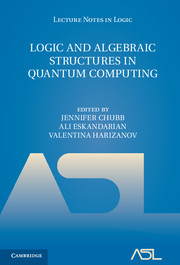Book contents
- Frontmatter
- Contents
- Preface
- Introduction
- 1 A (very) brief tour of quantum mechanics, computation, and category theory
- 2 Could logic be empirical? The Putnam-Kripke debate
- 3 The essence of quantum theory for computers
- 4 Fiber products of measures and quantum foundations
- 5 Operational theories and categorical quantum mechanics
- 6 Relating operator spaces via adjunctions
- 7 Topos-based logic for quantum systems and bi-Heyting algebras
- 8 The logic of quantum mechanics – Take II
- 9 Reasoning about meaning in natural language with compact closed categories and Frobenius algebras
- 10 Knot logic and topological quantum computing with Majorana fermions
- Index
- References
9 - Reasoning about meaning in natural language with compact closed categories and Frobenius algebras
Published online by Cambridge University Press: 05 June 2016
- Frontmatter
- Contents
- Preface
- Introduction
- 1 A (very) brief tour of quantum mechanics, computation, and category theory
- 2 Could logic be empirical? The Putnam-Kripke debate
- 3 The essence of quantum theory for computers
- 4 Fiber products of measures and quantum foundations
- 5 Operational theories and categorical quantum mechanics
- 6 Relating operator spaces via adjunctions
- 7 Topos-based logic for quantum systems and bi-Heyting algebras
- 8 The logic of quantum mechanics – Take II
- 9 Reasoning about meaning in natural language with compact closed categories and Frobenius algebras
- 10 Knot logic and topological quantum computing with Majorana fermions
- Index
- References
Summary
Abstract. Compact closed categories have found applications in modeling quantum information protocols by Abramsky-Coecke. They also provide semantics for Lambek's pregroup algebras, applied to formalizing the grammatical structure of natural language, and are implicit in a distributional model of word meaning based on vector spaces. Specifically, in previous work Coecke-Clark- Sadrzadeh used the product category of pregroups with vector spaces and provided a distributional model of meaning for sentences. We recast this theory in terms of strongly monoidal functors and advance it via Frobenius algebras over vector spaces. The former are used to formalize topological quantum field theories by Atiyah and Baez-Dolan, and the latter are used to model classical data in quantum protocols by Coecke-Pavlovic-Vicary. The Frobenius algebras enable us to work in a single space in which meanings of words, phrases, and sentences of any structure live. Hence we can compare meanings of different language constructs and enhance the applicability of the theory. We report on experimental results on a number of language tasks and verify the theoretical predictions.
Introduction. Compact closed categories were first introduced by Kelly [19] in early 1970's. Some thirty years later they found applications in quantum mechanics [1], whereby the vector space foundations of quantum mechanics were recasted in a higher order language and quantum protocols such as teleportation found succinct conceptual proofs. Compact closed categories are complete with regard to a pictorial calculus [19, 35]; this calculus is used to depict and reason about information flows in entangled quantum states modeled in tensor spaces, the phenomena that were considered to be mysteries of quantum mechanics and the Achilles heel of quantum logic [4]. The pictorial calculus revealed the multi-linear algebraic level needed for proving quantum information protocols and simplified the reasoning thereof to a great extent, by hiding the underlying additive vector space structure.
Most quantum protocols rely on classical, as well as quantum, data flow. In the work of [1], this classical data flow was modeled using bi-products defined over a compact closed category. However, the pictorial calculus could not extend well to bi-products, and their categorical axiomatization was not as clear as the built-in monoidal tensor of the category.
- Type
- Chapter
- Information
- Logic and Algebraic Structures in Quantum Computing , pp. 199 - 222Publisher: Cambridge University PressPrint publication year: 2016
References
- 6
- Cited by



